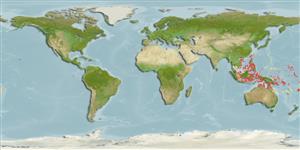>
Gobiiformes (Gobies) >
Gobiidae (Gobies) > Gobiinae
Etymology: phaeosticta: Name from Greek 'phaeos' meaning brown or dusky, and 'stictus' for small spots; refers to the profusion of small dark spots on the body.
Eponymy: Professor Cornelius Jan van der Horst (1889–1951) was a Dutch zoologist who moved to South Africa (1928) and became Head of the Zoology Department, Witwatersrand University, Johannesburg. [...] (Ref. 128868), visit book page.
More on authors: Randall, Shao & Chen.
Environment: milieu / Klimaatzone / Diepte / distribution range
Ecologie
marien rifbewoner; diepte 8 - 20 m (Ref. 90102). Tropical
Western Pacific: east Indian region (Sumatra eastward), south to New Caledonia; north to Ryukyu Is.
Grootte / Gewicht / Leeftijd
Maturiteit: Lm ? range ? - ? cm
Max length : 2.4 cm SL (female)
Korte beschrijving
Determinatiesleutels | Morfologie | Morfometrie
Dorsale stekels (totaal) : 6 - 7; Dorsale zachte stralen (totaal) : 12 - 13; Anale stekels: 1; Anale zachte stralen: 13. Characterized by having variable color, often pale grey to yellowish with row of large, diffuse blackish blotches on lower half of side; blue-edged yellow spots prominent on lower side between or on margin of blackish blotches; 6-7 diffuse, blackish saddles on back; head with yellow oblique bands; yellow pelvic fins with blue spots in adult ale; dorsal fin rays with short brown lines; prolonged filament formed by third dorsal spine, sometimes more than 50% SL in adult male; united pelvic fins, presence of well developed frenum; longitudinal scale series 46-52; circumpeduncular scales 11-12; cycloid body scales; head without scales except side of nape; greatest depth of body 5.8-6.5 in SL: ovate caudal fin, longer than head length (Ref. 90102).
Body shape (shape guide): elongated; Cross section: oval.
Inhabits sandy shores, sometimes in seagrass, in 8-20 m (Ref 90102).
Levenscyclus en paargedrag
Maturiteit | Voortplanting | Paaien | Eieren | Fecunditeit | Larven
Randall, J.E., K.-T. Shao and J.-P. Chen, 2007. Two new shrimp gobies of the genus Ctenogobiops (Perciformes: Gobiidae), from the Western Pacific. Zool. Stud. 46(1):26-34. (Ref. 75863)
Status op de Rode Lijst van het IUCN (Ref. 130435: Version 2025-1)
Gevaar voor de mens
Harmless
Gebruik door de mens
Tools
Speciale rapporten
Download XML
Internetbronnen
Estimates based on models
Preferred temperature (Ref.
123201): 26.7 - 29.4, mean 28.7 °C (based on 1110 cells).
Fylogenetische diversiteitsindex (Ref.
82804): PD
50 = 0.5000 [Uniqueness, from 0.5 = low to 2.0 = high].
Bayesian length-weight: a=0.00724 (0.00339 - 0.01546), b=3.10 (2.92 - 3.28), in cm total length, based on LWR estimates for this (Sub)family-body shape (Ref.
93245).
Trofisch niveau (Ref.
69278): 3.1 ±0.3 se; based on size and trophs of closest relatives
Weerstandsvermogen (Ref.
120179): Hoog, minimale populatieverdubbelingstijd minder dan 15 maanden (Preliminary K or Fecundity.).
Fishing Vulnerability (Ref.
59153): Low vulnerability (10 of 100).
🛈
